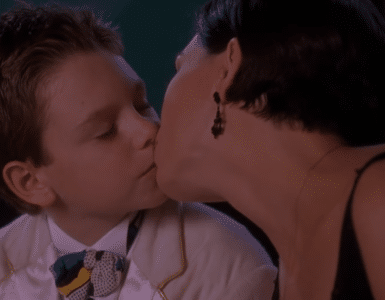18-year-old British internet “prankster” Mizzy, whose real name is Bacari-Bronze O’Garro, was recently arrested by UK police for breaching a criminal behavior order. O’Garro had been posting videos on his social media of him and his friends barging into people’s homes without their permission or consent.
One of the victims of the home invasion tells them, “We’ve got kids.” And you can hear the father’s confused child in the background.
O’Garro has posted several home invasion videos where most of the unsuspecting people in the homes are families with young children. But his content only gets worse. In one video, O’Garro steals a woman’s little dog at the park. In another, he’s going up to random women and asking her if she wants to die.
TikTok and YouTube have banned O’Garro from their platforms, but he’s still active on Snapchat, Twitter, and Twitch. It’s clear that O’Garro is doing anything he can to get attention and clout and will keep escalating his sociopathic behavior until the law intervenes.
In an interview with The Independent, O’Garro said “Controversy, even though it’s not good, is the best way to blow up on social media. I always know outrage is going to happen. I know exactly what I’m doing and the consequences of my actions.”
Just like many young clout-chasers, O’Garro doesn’t care that he’s upsetting and hurting so many people. He goes on to say “…it’s the fact that people are talking that’s important”.
This is the next level of prank videos which aren’t pranks at all but full-on harassment and crimes that intimidate, harm, and traumatize unsuspecting people. In the quest for clout, these sadists will stop at nothing to get people talking about them.
What is a Prank Channel?
Prank channels are supposed to contain videos where practical jokes, pranks, or tricks are played on people to make them laugh, surprise them, or scare them. What too many channels end up becoming, however, are harassment videos that can get so extreme that they traumatize and hospitalize the people being pranked.
Prank Channels Get Billions of Views
Prank videos can get hundreds of millions of views per video. That’s why so many young people dying for attention on the internet make them. It’s the easiest way to get engagement and the more outrageous you are, the more views and attention you get.
Kids tend to be the biggest audience for prank videos since they find them funny and entertaining. Kids are more likely to watch pranks videos over and over and will keep clicking on similar content.
There are kid-safe prank channels and channels that don’t harm anyone, but there are also a lot that do harm and are not good for kids.
I think it’s worth noting that when I tried to look for kid-safe pranks on YouTube to link to as an example, I just saw a bunch of problematic videos. Some pranks can result in legal repercussions for both the pranksters and the victims.
Bacari-Bronze O’Garro’s arrest is just one of many online “prank” creators who’ve been arrested for stunts. They don’t care that they get arrested and will keep doing dangerous and hurtful pranks because it gets views.
YouTuber Charles Ross was arrested 6 times and didn’t even bat an eye. One of the reasons Ross was arrested was for impersonating a police officer. He told Jacksonville.com, “I didn’t care then because I was blowing up on YouTube, and every time I did something wild I’d just get more views and more money, so it didn’t even matter.”
Charles Ross has two prank channels: Vlog Creations which has 3.44 million subscribers and nearly a billion channel views, and RossCreations which has 1.46 million subscribers and over 300 million channel views.
Controversial YouTuber, JiDion, who has 7.16 million subscribers, just posted a video called “I Got Arrested…AGAIN!” In the video, JiDion, whose real name is Jidon Adams, puts on prosthetic makeup to make himself look like an old man. He goes to a busy mall and fakes having an episode which startles passersby who rush to help the “old man.”
The police get called and recognize who he is and he’s given several warnings to leave before he’s arrested. Not wanting to pass up good “content” Adams’ friend secretly films him inside the police station even after police told him not to.
Another recent video on the “prank” channel is called “Why Incest Should be Legalized.” Where he and another famous prank YouTuber challenge each other to do the most cringey and offensive stunts.
Adams clearly wants to shock and be as extreme as he can for views and it works. His channel has over half a billion views, with a good portion of his audience being underage boys. Adams is best known for harassing people at public events and getting kicked out and has been permanently banned from Twitch for harassing female Twitch streamer, Pokimane.
Some of the biggest prank influencers go to extremes for views and normalize harassing strangers. Some of those extremes end up with the pranksters themselves getting hurt.
A Youtuber named Timothy Wilks was shot and killed when he pretended to rob a group of people in the parking lot. Another YouTuber named Tanner Cook was shot at a mall after he tried to pull a prank on a stranger.
Not only are the online harassers dealing with the medical and legal consequences of their extreme actions to get views, but the random people who ended up shooting them or fighting them also now have to deal with legal proceedings and emotional trauma from being put in the position where they felt they needed to defend themselves.
YouTube Bans Dangerous Pranks
In 2019, YouTube updated its policy to ban dangerous pranks on its channel. A spokesperson for YouTube told CNN, “YouTube has long prohibited videos which promote harmful or dangerous activities and we routinely review and update our enforcement guidelines to make sure they’re consistent and appropriately address emerging trends.”
The Harassment Videos Continue
Even with that policy in place, there is no shortage of harmful and dangerous harassment videos on YouTube.
One channel, aptly named TopNotch Idiots, frequently posts “hood prank” videos where they pick fights with and harass people living in low-income areas. The channel currently has over 3.37 million subscribers.
A former YouTuber named Trevon Sellers went viral after posting a video where he offered to buy a homeless man a burger and instead of giving it to him, Sellers ate it in front of him. The backlash Sellers got was so bad that he deleted his channel and deactivated his Instagram account. He tried to defend himself, saying the video was taken out of context. He had asked the homeless man beforehand if he could shoot that video, but it’s still wrong and disgusting and he still got canceled.
Just like with family vlogs, the allure of views and money gets to be so strong that too many clout-chasers take it too far. Not every single prank influencer is toxic and harasses people, but enough are to make prank channels a problem.
Prank Videos Can Cause Psychological Damage
Sometimes the person being pranked knows what’s happening beforehand and is just pretending to be surprised, scared or shocked. Other times, they’re strangers and end up being victims when the prank goes too far.
According to Psychology Today: “Pranks can trigger past trauma, cause hypervigilance, or an erosion of trust in a relationship. They can also humiliate, especially when the prank footage is posted online.”
Pranks can have long-lasting psychological effects on the victims, leading to feelings of anxiety, fear, or humiliation. In extreme cases, victims may develop PTSD or experience other mental health issues as a result of traumatic pranks. Pranks that target personal insecurities or sensitive subjects can be particularly damaging and contribute to emotional distress.
Lack of Consent and Boundaries
Many prank channels do not care about consent and will harass people at random. They might try to get consent after the prank in order to be able to show the strangers’ faces in their videos. Some channels will also try to undo the damage caused by offering the victims of harassment money, but that does not make it ok.
Someone might accept money for being pranked because they really need that money or want some kind of compensation, but they can still not be ok with being harassed in the first place and it can still harm them if the prank is extreme or triggers past trauma.
Pranks teach impressionable kids that it’s ok to harass others and push their boundaries without their consent. Even if the online harasser does get consent beforehand, they never make it clear in their videos and are still showing that it’s ok to go up to strangers and upset them, scare them, or trigger them in some way.
Should Kids Watch Prank Videos?
I personally don’t see anything positive about prank videos, but it just depends on your values. Kids need to learn empathy, boundaries, and consent, and prank channels teach the opposite of that.
If you have a child or teen who loves prank videos, have a conversation with them about it. Ask them why they like it, and try watching some videos together to see what types of pranks they’re watching. If they’re watching something problematic or extreme, talk to them about it and explain how those kinds of pranks can hurt people and have serious consequences. Ask them how they would feel if someone played that prank on them.
What do you think about prank channels? Do you think they’re horrible or funny? Do your kids like them? Let us know in the comments!










Add comment